 Every warmer day, there are new signs of the damage sustained in the landscape from our once in better than a lifetime winter. The news is discouraging. Any gardener who has zone 5 or 6 plants in their landscape is feeling the side effects of a zone 3 or 4 winter. I do not know the cultivar of pine in this neighborhood garden, but I am quite sure these trees are bone dead. I was a long ways away, but a close inspection was unnecessary. That saturated orange brown color on every needle but for the very bottom branches-very bad news.
Every warmer day, there are new signs of the damage sustained in the landscape from our once in better than a lifetime winter. The news is discouraging. Any gardener who has zone 5 or 6 plants in their landscape is feeling the side effects of a zone 3 or 4 winter. I do not know the cultivar of pine in this neighborhood garden, but I am quite sure these trees are bone dead. I was a long ways away, but a close inspection was unnecessary. That saturated orange brown color on every needle but for the very bottom branches-very bad news.
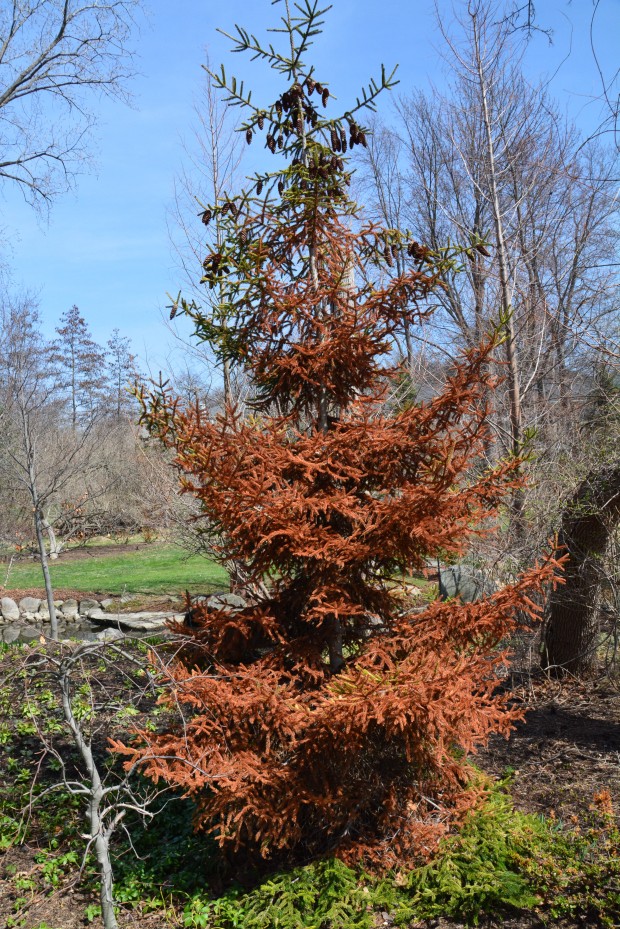 Our past winter was a once in 130 year event. Record cold. Record snow. The ice on the Great Lakes-3 feet thick. The ice on the Great Lakes are still 40% covered with ice. Some say it will be well into June before all that ice melts. Chilly is the prediction for our immediate future. This specialty and marginally hardy spruce grew and prospered in this client’s garden, for going on thirty years. This past winter proved too be too cold. Just too cold. No one could have foreseen a winter like this, nor could this spruce have been protected. Unless you are older than 130 years, this is this first time you have seen a winter this fierce.
Our past winter was a once in 130 year event. Record cold. Record snow. The ice on the Great Lakes-3 feet thick. The ice on the Great Lakes are still 40% covered with ice. Some say it will be well into June before all that ice melts. Chilly is the prediction for our immediate future. This specialty and marginally hardy spruce grew and prospered in this client’s garden, for going on thirty years. This past winter proved too be too cold. Just too cold. No one could have foreseen a winter like this, nor could this spruce have been protected. Unless you are older than 130 years, this is this first time you have seen a winter this fierce.
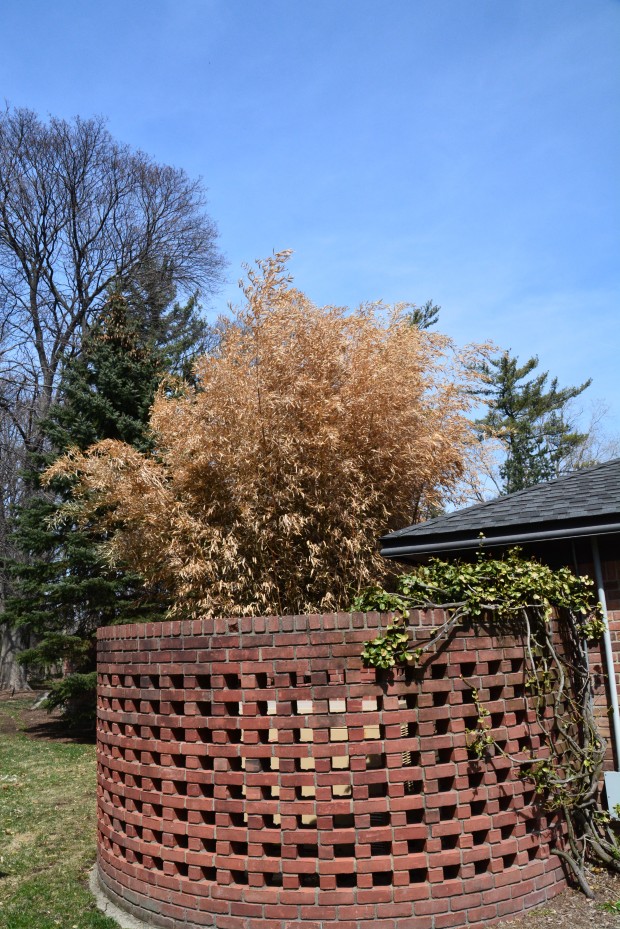 Like other stands of mature bamboo I have seen this spring, the culms and leaves are dead. It is impossible to predict yet if the roots survived. Time will tell. We have had a very long period of mild winters. That length of time was long enough to tempt gardeners to push the limits. My magnolia stellata bloomed today. The flowers are small, and look like wet kleenex. Not that I am complaining. I am shocked it is blooming at all. Planting magnolias in a northern zone is a leap of faith. A story about hope. Our winter was very rough, and every gardener in my zone is being educated daily about how that winter is intruding on our spring.
Like other stands of mature bamboo I have seen this spring, the culms and leaves are dead. It is impossible to predict yet if the roots survived. Time will tell. We have had a very long period of mild winters. That length of time was long enough to tempt gardeners to push the limits. My magnolia stellata bloomed today. The flowers are small, and look like wet kleenex. Not that I am complaining. I am shocked it is blooming at all. Planting magnolias in a northern zone is a leap of faith. A story about hope. Our winter was very rough, and every gardener in my zone is being educated daily about how that winter is intruding on our spring.
 I have not seen a single Alberta spruce untouched by the winter. Every neighborhood I have visited has alberta spruce burned on the south side. Some very exposed locations show burn all around. Fierce burn.
I have not seen a single Alberta spruce untouched by the winter. Every neighborhood I have visited has alberta spruce burned on the south side. Some very exposed locations show burn all around. Fierce burn.
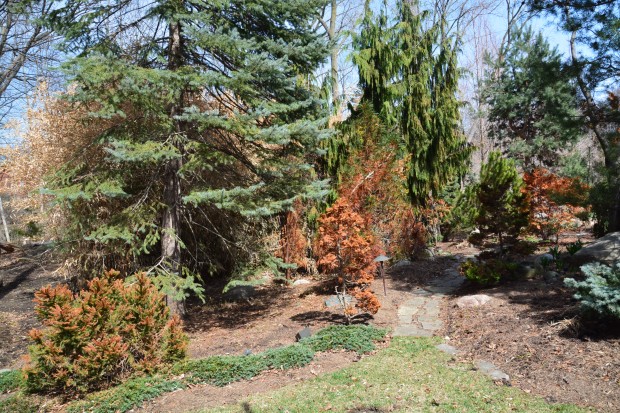 Many landscapes show damage which is hard to understand. Some plants are untouched. Others are burned all over. Others are burned in specific spots. Some have been killed outright. Do I have a simple and swift explanation-not really. Some species of plants that are marginally hardy in our area-many of these are in the killed outright list. Do I have zone 5 and 6 plants in my landscape-yes. A once in 130 year winter cycle would not prevent any gardener from testing the limits. The fact is, my 20 year old garden is but a short intermission in the bigger scheme of things. This spring is making me realize that nature bats both first and last. There is no negotiating once a winter tests the limits of cold hardiness.. Too cold is simply too cold. No zone 6 specialty conifer could not have fared well this past winter. I have no easy and simple answers.
Many landscapes show damage which is hard to understand. Some plants are untouched. Others are burned all over. Others are burned in specific spots. Some have been killed outright. Do I have a simple and swift explanation-not really. Some species of plants that are marginally hardy in our area-many of these are in the killed outright list. Do I have zone 5 and 6 plants in my landscape-yes. A once in 130 year winter cycle would not prevent any gardener from testing the limits. The fact is, my 20 year old garden is but a short intermission in the bigger scheme of things. This spring is making me realize that nature bats both first and last. There is no negotiating once a winter tests the limits of cold hardiness.. Too cold is simply too cold. No zone 6 specialty conifer could not have fared well this past winter. I have no easy and simple answers.
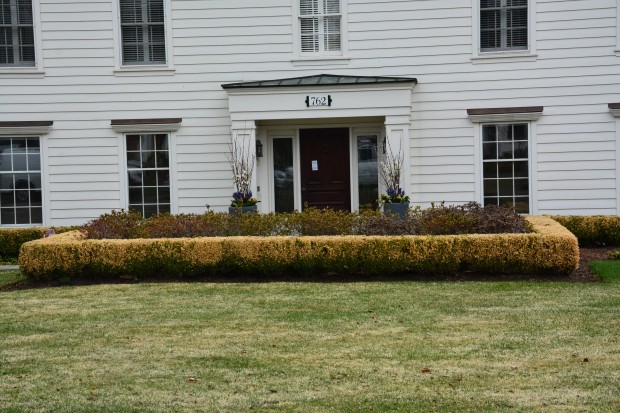 I love boxwood as much as the next gardener. Every Green Velvet boxwood in my garden at home is unscathed by this past winter. They are green and good to go. This boxwood hedge in a neighborhood garden south of me did not fare so well. The cause of the damage? Salt spray generated by cars driving by at a brisk speed is a toxic bath that can damage boxwood. Extremely low temperatures can test boxwood cultivars intended for warmer zones. Exposed plantings of boxwood were bleached by sun reflected off of deep snow. A boxwood that went into the winter dry can be severely damaged by cold winter winds. Evergreens need to be well watered in the fall. They cannot absorb water from the roots once the ground freezes. Water evaporates quickly from evergreen leaves given cold temperatures, wind and sun. The damage on this hedge is hard to pinpoint. How that damage should be handled-it is too early to tell.
I love boxwood as much as the next gardener. Every Green Velvet boxwood in my garden at home is unscathed by this past winter. They are green and good to go. This boxwood hedge in a neighborhood garden south of me did not fare so well. The cause of the damage? Salt spray generated by cars driving by at a brisk speed is a toxic bath that can damage boxwood. Extremely low temperatures can test boxwood cultivars intended for warmer zones. Exposed plantings of boxwood were bleached by sun reflected off of deep snow. A boxwood that went into the winter dry can be severely damaged by cold winter winds. Evergreens need to be well watered in the fall. They cannot absorb water from the roots once the ground freezes. Water evaporates quickly from evergreen leaves given cold temperatures, wind and sun. The damage on this hedge is hard to pinpoint. How that damage should be handled-it is too early to tell.
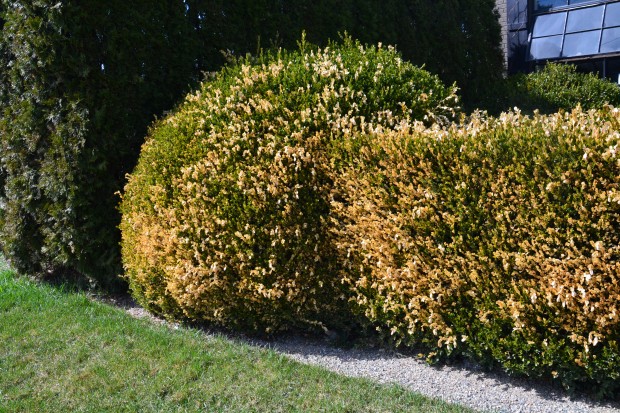 Boxwood is a broad leaved evergreen. It needs to be well watered and juicy before winter. Once the soil freezes, no boxwood can access the water it needs to keep the leaves juicy and green. The water available at the root is turned off. Strong winter winds makes the water in the leaves evaporate at an alarming rate. An evergreen cannot replace the water it looses by evaporation over the winter. What that leaf has to sustain it in November will have to do for the rest of the winter. An evaporation rate that exceeds the store of moisture means leaves will dry out and die.
Boxwood is a broad leaved evergreen. It needs to be well watered and juicy before winter. Once the soil freezes, no boxwood can access the water it needs to keep the leaves juicy and green. The water available at the root is turned off. Strong winter winds makes the water in the leaves evaporate at an alarming rate. An evergreen cannot replace the water it looses by evaporation over the winter. What that leaf has to sustain it in November will have to do for the rest of the winter. An evaporation rate that exceeds the store of moisture means leaves will dry out and die.
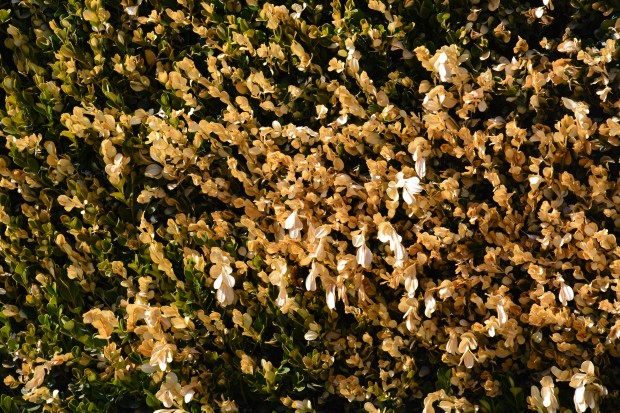 The boxwood leaves on the interior of the shrub, protected from salt winter wind and sun scald may survive the toughest winter. The damage I see on the boxwood at the shop makes me want to rush out there with my pruners. Notwithstanding my instinct to remove any sign of damage, I will wait. Viable branches that have lost their leaves will releaf, given some time. Boxwood damaged by repeated soaking in road salt may not recover. Marginally hardy varieties of boxwood may be dead from the cold. Hicks yews are not so wonderfully hardy. Yews pruned after August show striking signs of damage. I am inclined to wait and see how all of my plants will respond. Plants have a will to live. I would advise giving them the room they need to recover.
The boxwood leaves on the interior of the shrub, protected from salt winter wind and sun scald may survive the toughest winter. The damage I see on the boxwood at the shop makes me want to rush out there with my pruners. Notwithstanding my instinct to remove any sign of damage, I will wait. Viable branches that have lost their leaves will releaf, given some time. Boxwood damaged by repeated soaking in road salt may not recover. Marginally hardy varieties of boxwood may be dead from the cold. Hicks yews are not so wonderfully hardy. Yews pruned after August show striking signs of damage. I am inclined to wait and see how all of my plants will respond. Plants have a will to live. I would advise giving them the room they need to recover.
 A sick and challenged plant needs time to sort out the insult and injury on their own. This is my opinion. This spring following a once in a century winter-what do I know what will be? I do know this section of boxwood has been struggling with fungus for 4 years. An extraordinarily bad winter may have done them in.
A sick and challenged plant needs time to sort out the insult and injury on their own. This is my opinion. This spring following a once in a century winter-what do I know what will be? I do know this section of boxwood has been struggling with fungus for 4 years. An extraordinarily bad winter may have done them in.
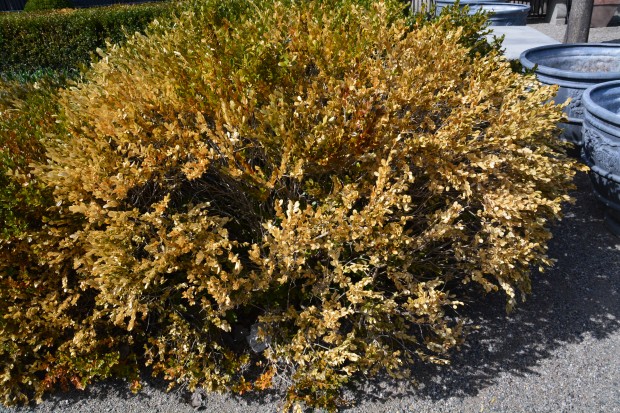 I have a plan to grieve privately about the damage to my beloved boxwood hedge, and wait. I know I need to wait for the plants to respond. Once they respond to warmer weather, I will know what to do. It is not clear yet what is lost, and what is burned, and needs pruning. Having never experienced a winter like this before, the last thing I want to do is interfere with the natural order of things. If you are as passionate a gardener as I am, the waiting will be horticultural hell. But all of us would go to hell and back for a garden, wouldn’t we?
I have a plan to grieve privately about the damage to my beloved boxwood hedge, and wait. I know I need to wait for the plants to respond. Once they respond to warmer weather, I will know what to do. It is not clear yet what is lost, and what is burned, and needs pruning. Having never experienced a winter like this before, the last thing I want to do is interfere with the natural order of things. If you are as passionate a gardener as I am, the waiting will be horticultural hell. But all of us would go to hell and back for a garden, wouldn’t we?
just today while driving through our neighborhood, and surveying my own property, i thought to myself “is this getting worse?”. “am i seeing things?” so when i see you say, every warmer day proves more damaging, maybe i am not seeing things. but what i see is heartbreaking.
same here in chicagoland; south facing, yews, alberta spruces, box and some thuja, young and old.
very enlightening deborah, have been wondering, do i cut now, wait??? appreciate the advice in this uncharted territory
debra
Dear Debra, the warmer the weather gets, the true extent of the damage done by our winter will become more apparent. I would advise you to wait, and not act too soon. The cause and cure of the damage is specific to every individual garden. The heartbreak part of this past winter is just now surfacing. My advice, let nature send you a sign. Wait for the sign. The worst thing would be to add insult to all the injury, by acting too soon. Let nature sort out the trouble in her own fashion, then act. Best, Deborah
My garden is as bad as the pictures you have posted my yellow groove bamboo is so yellow it’s gold my Alberta spruce looks as if it’s a rusted metallic ornament. my gardening inexperience keeps me optimistic time will tell.thank you for your blog it keeps me motivated.
Dear Kal, sit tight. Nature may surprise you. Hoping for the best for you, Deborah
another deb chiming in.
while i don’t have many evergreens on our acre, i have plenty of roses of all shapes and sizes. i’m hoping that the cold went deep enough here to decimate the rose midge plague that cost me blooms and tears all last summer. i like keeping things organic here & have hopes that somehow that will sort itself out. i have noticed an increase in assassin bugs so that gives me hope. meanwhile, i will be holding my breath as the second flush of roses sets bud — the first is usually unscathed.
Here in Akron, Ohio we are seeing similar widespread damage. Hollies, azaleas and boxwood have taken the worst hit. In some of the azaleas and holly, the inside of the stem is very faintly green, although the outside of the plants look brown and crispy. We are hoping, perhaps too optomistically, that they will leaf out again. I don’t expect to see many azaleas bloom. I hope I am wrong.
Dear Susie, we all will have losses. But I do believe we all will have some surprises. Write me again in a month. I hope you have some good stories to balance the bad ones. Thanks, Deborah
Yes I’m coming slowly to the very sad realization that my 30ish Endless Summer hydrangeas might be dead! I’m in shock. I’ve never had an issue with them before. There isn’t a single sign of life on any of them. My experience has been that they will usually start leafing out mid-end March. I’m hoping they are merely on delay. This past year they were still magnificentally blooming when the first snow fell on them, and I think they were violently pushed into dormancy rather than easing in. But I try to think of dead plants as opportunities for new things. After I dry my tears!
I don’t know where you are Stephen, but I am in the DC metro area where winter was also simply terrible. I have two endless summer hydrangeas, and only in the past two days have I been able to detect the tiniest bits of green leaf emerging from the base. My limelights and annabelles have fully leafed (is that the word?)… As our host so eloquently said, time will tell. I’m hoping for the best.
Dear Stephen, those hydrangeas may surprise you. Wait and see. Best, Deborah
Cutting too soon with some more hard frosts in the near future I think would be counter to the message our plants need to receive…but sometimes as some of your pictures illustrate, spruce, some yews, pines…dead is dead.
Dear Rachelle, I think I know when a plant is dead. But this year, never having experienced anything like this winter, I will wait as long as I can. Even when I think there is no hope, I will hope. Best, Deborah
While we did not have the feet of snow that you did, here in KC our gardens were subjected to sub-zero temperatures and horrific wind chills that persisted for weeks. Had it been merely a few days I believe our plants would have fared better. Coupling the rudeness of this past winter with a multiple-year drought and the result is a very bitter spring indeed. In my own garden the evergreens fared the worst – what isn’t burned is horribly dead. From Leylandi Cypress to Spartan Juniper to Mugo Pine…all are dried out cusps of what was once a thriving 7-10 yr old partnership anchoring major areas in the landscape. No amount of water would have changed the outcome. Change is inevitable – but when the old mantra “the best time to plant a tree is 10 years ago” replays in my head – it only serves to steer me toward those evergreen anchors that are hardy in zones 4-5, so as to avoid the heartbreakers in zone 6. Alas, I will take your advice and wait a while to see how nature sorts itself out before diving in to rescue what might remain. Blessings.
Dear Kristol, I err on the side of hardy when I plant for clients. But erring on the side of caution was no defense against this winter. We will all be picking up the pieces in the next month. That’s what gardeners do. Thanks, Deborah
Thank you for making me feel just a little bit better about all this. I believe that the saying states that “misery loves company.” Well….seeing your boxwood hedge at the shop made me feel sad….and also like I am not completely alone. (SO HAPPY to hear that the hedge at home is aok.) Maybe it is a blessing that we have not gotten all the way to your past posting entitled “100 Pots of Boxwood” quite yet. I can’t really tell what is going on with the thirty or so that we already have. My beautiful boxwood topiary from last DGW season — the one the looks like it is from Whoville — not so sure about it….but I remain hopeful. The two basque rope pots with ginormous green velvet…maybe/maybe not. Some pots are clearly dead….but many of them seem to be in limbo. Watering lots….everyone has been given a first Spring feeding. And now all we can do is wait, I guess. I have gladly handed myself over to Dr. Silver on this one and await further instructions. Gulp.
Michael, it was never truer than right now to say that nature bats last. We will all deal with the past winter as best we can. I would only counsel that you wait, and wait some more. The little, big and the well loved die,in spite of our efforts and our caring. Life is like that. Deborah
All the ivy above ground level was hit. All around Grosse Pointe Trees and homes enhanced by the glossy greenery are now hung with raggedy brown, crispy leaves. Will they leaf out? Time will tell. Meanwhile it feels like fall here as more and more dead ivy leaves drop off my sycamore.
Dear Janet, the stems may be alive, even if the leaves are dead. If the ivy stems scratch green, then there is the hope they will releaf. This process will take a while. I would not be surprised if it was June. But I am just guessing. Like you, I have never seen this before. I am hoping for the best, Deborah
Deborah, I can feel the pain and suffering in your words! Life is so unpredictable and if you take solace in your garden to see it so devastated by a record breaking cold winter must be so difficult. I am glad you are going to wait and see what some of the plants will do. It is hard to plant for the long term with our ever changing weather patterns and potential climate change. Even Houston had a cold winter with temperatures down around 20 and even a few nights in the teens. That is just not our weather and the tropical just didn’t make it! I have a lovely Blue Sky thunbergia vine that really is hardy in zone 10…but I planted it anyway after seeing it growing so beautifully in Puerto Vallarta. It burnt to the ground and I thought it was a goner but i left it till the last freeze was past and then we clean off all the dead. And just this week I am now seeing little green vines reaching up out of the gnarly root stump and twining around the arbor. I hope your beloved plants do as well!!!
Dear Laurin, Every gardener has a particular story about their troubles and their triumphs. Later in the season, I am sure I will be hearing about what survived, and what was reimagined from what didn’t survive. Better days are ahead. Thanks, Deborah
A quote from a great English gardener:
A garden is a grand teacher. It teaches patience and careful watchfulness; it teaches industry and thrift; above all it teaches entire trust.
Gertrude Jekyll
Hi Deborah,
i have limited experience on this topic. Especially from near Dallas, TX, though we had our own share of ice and cold woes this past winter. Nothing like yours by any means, but bad for us.
I weigh in merely to reinforce your guidance to wait. Fight every instinct to think all is lost and tear out or prune to the nubs, and instead give everything a bit more time. In our case, a good four weeks longer than “normal”.
In only the past week, much of what we thought was completely gone has slowly resurrected. Not all, but a fair portion of what we’d given up on. As you have coached so often, the will for a plant to survive is strong. Incredibly so. Miraculously. new growth has sprung from places we didn’t think possible, and the crispy parts have mostly sloughed off by themselves, no human intervention required. Not to say there won’t be eventual pruning and cleanup required. But not yet. We’re not touching it yet.
It’s so tempting to want to “fix” when things go wrong in the garden. Hit the restart button. Allowing ‘nature to take its course’ rolls off the tongue, but is near impossible to execute. Keeping our mitts OFF the landscape was the absolute best thing we could have done this spring. Also the hardest.
Thus far, the wait has been worth it. I hope for the same outcome for you.
Dear Anne, loved this letter. My thanks to you for writing it. Deborah
Ok…..depressing enough, dead yews, dead roses, deer decimated arborvitaes!!! Let’s get some good news, I read in the Chicago Tribune that the Japanese beetle population has suffered dramatically from the cold:-)!
Dear Karen, I am happy to hear that the Japanese beetles have been decimated by this winter. It is indeed a bright spot. Best, Deborah
I was so proud of my collection of 8ft tall Irish Yews (taxus baccata) … they are all browned out with no sign of green even in the bark. I took out a smaller one – the roots are remarkably intact and vibrant though. I am seeing green growth up to 1 ft (which was covered by snow). Tempted to cut them all down to a size of 1 ft and seen what happens. But I will wait a few weeks … I must say, this is REAL heart break.
Antoine, Don’t be tempted. Wait until you are blue in the face. Don’t cut until you have a clear sign about what those plants are going to do. They have endured the most brutal winter. Give them the time they need. Don’t let the heartbreak make you act too soon. This is my opinion, Deborah
Hi Deborah,
I am in Rhode Island & I wish I had checked in with you before Friday as I could wait no longer. The 3 year old boxwoods at the front of the house (south facing) were so winter burned. So I trimmed away the brown. One in particular would’ve been thrown away for dead by many others. But my heart is hopeful. The other 17 boxwoods on my property are unaffected. A few in pots, the rest in the ground. Coincidentally the ones that fared so poorly had a psyillid infection last year – at least I thought that’s what it was – where the leaves on the end of the branches cupped and curled up. I treated it during the season. I’m thinking a combination of that and the harsh winter
The row of Japanese holly behind the boxwoods did fine except for one. The one in the middle.
Go figure.
Here’s to our season of rebirth.
Debra
I love that you post issues that happen in your garden- we can all relate. I have a boxwood that has a section of tinged orange leaves- it seems to be spreading. They are fairly established box so I have half a mind to spray paint the darn things green! lol
-Mary
On June 1 my box woods. Look like your last photo after some earlier pruning. Do we cut back to18 inches or plant anew?
Dear Kathy, scratch the woody stems in a few places. If they are green under the bark, the stems are alive. If the stems are brown inside the bark, and snap off, chances are good they are dead.That said, I am not in your yard. You have to make the call as best you can. Thanks, Deborah
Deborah,
Any ideas about yellowing boxwoods if the prior winter was not harsh, they looked absolutely green and marvelous all winter long and all summer (and they have been in my backyard for YEARS with no problems or changes in drainage)? Now, and it seems like all of a sudden, almost an entire row is yellow and it seems to be spreading down the row?
On an unaffected (non-yellowing) nearby row, I’ve seen some stark white edges on just a few leaves … don’t know if that is of any significance.
The yellow row has green and yellow leaves, but the yellow leaves are definitely in the majority.
We did have to cut down a huge tree (that was across the yard) about 3 weeks ago and I wish I could remember whether the boxwoods were yellowing before the tree was cut.
Anyway, am just sick about it. I can’t see any fungus or aphids or anything that would cause this, although I am no gardener so I could certainly be missing something. But to my untrained eye, all I see are just progressively yellowing leaves.
Thanks a TON for any suggestions you might have.
Taylor, call an arborist in your area, and get a consult. Good luck, Deborah